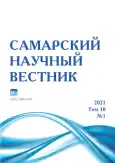Сезонная антимикробная активность летучих выделений представителей рода Begonia L. (Begoniaceae)
- Авторы: Цыбуля Н.В.1, Фершалова Т.Д.1
-
Учреждения:
- Центральный сибирский ботанический сад СО РАН
- Выпуск: Том 10, № 1 (2021)
- Страницы: 167-172
- Раздел: Общая биология
- URL: https://journals.rcsi.science/2309-4370/article/view/70437
- DOI: https://doi.org/10.17816/snv2021101126
- ID: 70437
Цитировать
Полный текст
Аннотация
Статья продолжает многолетние комплексные исследования многочисленных таксонов тропического рода Begonia, позволяющие на основании выявленных морфологических, ритмологических и биохимических признаков оценить адаптивные возможности представителей этого рода. Изучение антимикробной активности интактных растений и различных фракций их экстрактов позволило выделить несколько перспективных представителей рода в отношении широкого спектра тестовых микроорганизмов. Использование этих растений в составе фитомодулей в детских учреждениях привело к существенному снижению общей микробной загрязненности воздушной среды. В работе представлены результаты экспериментального исследования сезонной антимикробной активности 13 видов и 8 гибридов. Оценка фитонцидной активности проведена с использованием метода «опарения» летучими соединениями листьев штриховых посевов микробных тест-культур – бактерий Staphylococcus epidermidis, Esсherichia coli и грибов Candida albicans. Установлено, что 95% бегоний отличаются выраженной активностью в отношении к бактериям S. epidermidis, 48% – к бактериям E. coli и 43% – к грибам Candida albicans. Отмечена сезонная специфичность антимикробного действия бегоний: наибольшее ингибирование роста колоний бактерий S. epidermidis наблюдается в весенне-летний период в фазу интенсивного роста, а E. coli осенне-зимний период в фазу умеренного роста. Выявлены таксоны с выраженным, продолжительным и универсальным антимикробным действием в отношении к исследованным тест-объектам для практического озеленения различных типов интерьеров. Полученные данные могут служить основой для дальнейшего исследования химического состава летучих экзометаболитов на примере представителей секций Gireoudia и Coelocentrum, показавших высокую антимикробную активность к S. epidermidis и E. coli.
Полный текст
Открыть статью на сайте журналаОб авторах
Наталья Владимировна Цыбуля
Центральный сибирский ботанический сад СО РАН
Автор, ответственный за переписку.
Email: ntsybulya@yandex.ru
кандидат биологических наук, старший научный сотрудник лаборатории фитохимии
Россия, НовосибирскТатьяна Дмитриевна Фершалова
Центральный сибирский ботанический сад СО РАН
Email: fershalova@ngs.ru
кандидат биологических наук, научный сотрудник отдела научно-образовательных программ
Россия, НовосибирскСписок литературы
- Байкова Е.В., Фершалова Т.Д., Карпова Е.А., Цыбуля Н.В., Набиева А.Ю. Изучение интродукционной коллекции рода Begonia L. в Центральном сибирском ботаническом саду СО РАН (Новосибирск) // Растительный мир азиатской России. 2016. № 4. С. 88–97.
- Фершалова Т.Д., Байкова Е.В. Интродукция бегоний в оранжереях и интерьерах. Новосибирск: Академическое изд-во «Гео», 2013. 157 с.
- Акимов Ю.С., Лишванова Л.Н. Зависимость летучести соснового эфирного масла от его состава // Бюллетень государственного Никитского ботанического сада. 1977. Вып. 2 (33). С. 47–51.
- Цыбуля Н.В., Фершалова Т.Д., Якимова Ю.Л. Роль медико-экологического фитодизайна в санации воздушной среды помещений детских учреждений // Дезинфекционное дело. 2018. № 1 (103) С. 31–36.
- Байкова Е.В., Фершалова Т.Д., Карпова Е.А. Структурные типы трихом в роде Begonia (Begoniaceae): обзор литературы // Растительный мир Азиатской России. 2019. № 2 (34). С. 39–55. doi: 10.21782/RMAR1995-2449-2019-2(39-54).
- Карпова Е.А., Фершалова Т.Д., Якимова Ю.Л. Содержание флавоноидов и антимикробные свойства листьев некоторых видов рода Begonia // Современная наука. Актуальные проблемы теории и практики. Естественные и технические науки. 2018. № 1. С. 1–10.
- Карпова Е.А., Цыбуля Н.В., Храмова Е.П., Якимова Ю.Л., Фершалова Т.Д. Антимикробная активность и содержание флавоноидов у некоторых представителей рода Begonia L., используемых в фитодизайне // Вопросы биологической, медицинской и фармацевтической химии. 2011. № 1. С. 8–16.
- Savitsky E., Fershalova T., Tsybuly N. Seasonal antimicrobial activity of the volatile exometabolites of some tropical lianas during introduction // Plant diversity: status, trends, conservation concept: BIO Web of Conferences. 2020. Vol. 24. doi: 10.1051/bioconf/20202400074.
- Doorenbos J., Sosef M.S.M., Wilde J.J.F.E. de The sections of Begonia: including descriptions, keys and species lists // Wageningen Agricultural University Papers. 1998. Vol. 98, № 2. P. 1–266.
- Цыбуля Н.В. Методика определения фитонцидной активности интактных растений // Растительные ресурсы. 2000. № 2. 106–115.
- Делова Г.В. Фитонцидные свойства некоторых древесных и кустарниковых пород // Фитонциды, их биологическая роль и значение для медицины и народного хозяйства: мат-лы совещ. 25–28 сентября 1965 г. Киев: Наукова думка, 1967. С. 115–119.
- Бакулин В.Т., Чиндяева Л.Н., Цыбуля Н.В. Антимикробная активность листьев тополей и ив (Salicaceae) в Сибири. Проблемы региональной экологии. 2010. № 6. С. 60–64.
- Frei B., Heinrich M., Herrmann D., Orjale J.E., Schmitt J., Sticher O. Phytochemical and biological investigation of Begonia heracleifolia // Planta Medica. 1998. № 64. P. 385–386.
- Chirol N., Jay M. Acylated anthocyanins from flowers of Begonia // Phytochemistry. 1995. Vol. 40 (1). P. 275–277.
- Basile A., Giordano S., Lopez-Saez J.A., Cobianchi R.C. Antibacterial activity of pure flavonoids isolated from mosses // Phytochemistry. 1999. № 52. P. 1479–1482.
- Pepeljnak S., Kalodera Z., Zovko M. Antimicrobial activity of flavonoids from Pelargonium radula (Cav.) L’Herit // Acta Pharmaceutica. 2005. № 55. P. 431–435.
- Gatto M.T., Falcocchio S., Grippa E., Mazzanti G., Battinelli L., Nicolosi G., Lambusta D., Saso L. Antimicrobial and antilipase activity of quercetine and its C2-C16 3-O-Acyl-Esters // Bioorganic & Medicinal Chemistry. 2002. № 10. P. 269–272. doi: 10.1016/s0968-0896(01)00275-9.
- Choi H.-J., Kim J.-H., Lee C.-H., Ahn Y.-J., Song J.-H., Baek S.-H., Kwon D.-H. Antiviral activity of quercetin 7-rhamnoside against porcine epidemic diarrhea virus // Antiviral Research. 2009. Vol. 81, № 1. P. 77–81. doi: 10.1016/j.antiviral.2008.10.002.
- Вересковский В.В., Горленко С.В., Кузнецова З.П., Довнар Т.В. Флавоноиды листьев Begonia erythrophylla // Химия природных соединений. 1987. № 6. С. 910.
- Suresh M., Irulandi K., Siva V., Mehalingam P. A short review on Ethnomedicinal uses, phytochemistry and pharmacology of Begonia malabarica Lam. // International Journal of Botany Studies. 2016. Vol. 1, № 1 (6). 2016. P. 16–17.
- Karpova E.A., Nabieva A.Yu., Fershalova T.D., Yakimova Y.L., Tsybulya N.V. Flavonoids and antimicrobial properties of Begonia fischeri var. palustris in vitro plantlets // OnLine Journal of Biological Sciences. 2019. Vol. 19 (1). P. 20–27. doi: 10.3844/ojbsci.2019.20.27.
Дополнительные файлы









